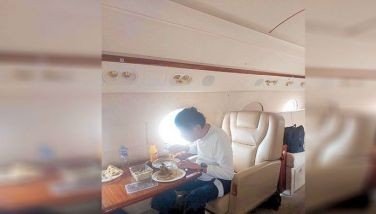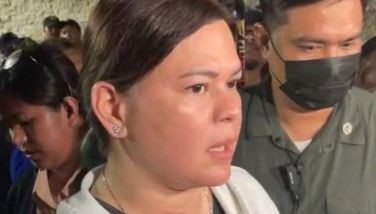Smuggling down, collections up, says Customs chief
March 23, 2005 | 12:00am
Smuggling incidents in the country are going down while government collection of taxes and duties is improving, Customs Commissioner Alberto Lina announced yesterday.
Lina said cases of smuggling had been reduced owing to stricter enforcement of procedure by the Bureau of Customs.
"Also to combat corruption, all ports in the Philippines are open for transaction from 7 a.m. to 7 p.m. with no noon break," Lina told reporters during an inspection of the Harbour Centre Port Terminal (HCPT) in Tondo, Manila.
Previously, commonly smuggled items included fruits and vegetables. "Now, there’s almost none because we already put up measures," he said.
"We double check the permits (and) the one giving authority to import vegetables and fruits is the Department of Agriculture. We are just implementing it," he said.
But in order to make the system work better, the customs chief said certain changes have to be made.
He noted that in paying taxes and duties, a "direct payment" mode is still used although it is prone to corruption. Direct payment is when taxes and duties are paid at the time the cargo arrives at Customs.
In the past, said Lina, letters of credit had been used which made it easier to identify rogue importers through the banks, unlike direct payment, whereby a smuggler could avoid being caught because there is no way to verify his identity.
"That is what we will change," the Customs chief vowed.
In cases where goods are misdeclared, Lina said more rigid procedures should be put in place. "There are also measures being done to counter-check (the goods)."
Technology and computerized record checking could be implemented further to prevent collusion, he said. "There would be less human intervention. We are applying this already but we will enhance it further."
At the HCPT, Lina described the private wharf as a "major player" in improving Customs’ revenue collection since it contributes 25 percent of the overall monthly tax collection of about P4.16 billion for the Port of Manila.
In February alone, he said the HCPT collected some P500 million in duties and taxes for the bulk cargo, which the private firm’s modernized facilities handle at the reclaimed Smokey Mountain site in North Harbor, Manila.
Lina predicted that tax collection at the privately owned wharf will increase further, given the increase in bulk cargo arriving at the HCPT. In addition, he said, the tariff increase from five percent to seven percent on imported steel would also contribute substantially to revenue collection by the Bureau of Customs.
HCPT president and chief executive officer Michael Romero said the current influx of bulk cargo and about 90 percent of non-containerized cargo has added to Customs contributions.
"We will make it a point to formally make a monthly collection target of P500 million, if not more, as more cargos arrive at the HCPT," said Romero.
At least 1,792,576.50 metric tons of steel products arrive yearly at the HCPT and 1,275,123.34 metric tons of non-grain products, as well as 1,50,678.06 metric tons of logs and lumber.
There are also 173,807.52 metric tons of bagged cargo and 28,016.26 metric tons of general cargo that arrive, or a total volume of 3,264,962.44 metric tons, said Customs collector Gerry Caylan, who is assigned to the HCPT.
Lina said cases of smuggling had been reduced owing to stricter enforcement of procedure by the Bureau of Customs.
"Also to combat corruption, all ports in the Philippines are open for transaction from 7 a.m. to 7 p.m. with no noon break," Lina told reporters during an inspection of the Harbour Centre Port Terminal (HCPT) in Tondo, Manila.
Previously, commonly smuggled items included fruits and vegetables. "Now, there’s almost none because we already put up measures," he said.
"We double check the permits (and) the one giving authority to import vegetables and fruits is the Department of Agriculture. We are just implementing it," he said.
But in order to make the system work better, the customs chief said certain changes have to be made.
He noted that in paying taxes and duties, a "direct payment" mode is still used although it is prone to corruption. Direct payment is when taxes and duties are paid at the time the cargo arrives at Customs.
In the past, said Lina, letters of credit had been used which made it easier to identify rogue importers through the banks, unlike direct payment, whereby a smuggler could avoid being caught because there is no way to verify his identity.
"That is what we will change," the Customs chief vowed.
In cases where goods are misdeclared, Lina said more rigid procedures should be put in place. "There are also measures being done to counter-check (the goods)."
Technology and computerized record checking could be implemented further to prevent collusion, he said. "There would be less human intervention. We are applying this already but we will enhance it further."
At the HCPT, Lina described the private wharf as a "major player" in improving Customs’ revenue collection since it contributes 25 percent of the overall monthly tax collection of about P4.16 billion for the Port of Manila.
In February alone, he said the HCPT collected some P500 million in duties and taxes for the bulk cargo, which the private firm’s modernized facilities handle at the reclaimed Smokey Mountain site in North Harbor, Manila.
Lina predicted that tax collection at the privately owned wharf will increase further, given the increase in bulk cargo arriving at the HCPT. In addition, he said, the tariff increase from five percent to seven percent on imported steel would also contribute substantially to revenue collection by the Bureau of Customs.
HCPT president and chief executive officer Michael Romero said the current influx of bulk cargo and about 90 percent of non-containerized cargo has added to Customs contributions.
"We will make it a point to formally make a monthly collection target of P500 million, if not more, as more cargos arrive at the HCPT," said Romero.
At least 1,792,576.50 metric tons of steel products arrive yearly at the HCPT and 1,275,123.34 metric tons of non-grain products, as well as 1,50,678.06 metric tons of logs and lumber.
There are also 173,807.52 metric tons of bagged cargo and 28,016.26 metric tons of general cargo that arrive, or a total volume of 3,264,962.44 metric tons, said Customs collector Gerry Caylan, who is assigned to the HCPT.
BrandSpace Articles
<
>
- Latest
- Trending
Trending
Latest
Trending
Latest
Recommended






























